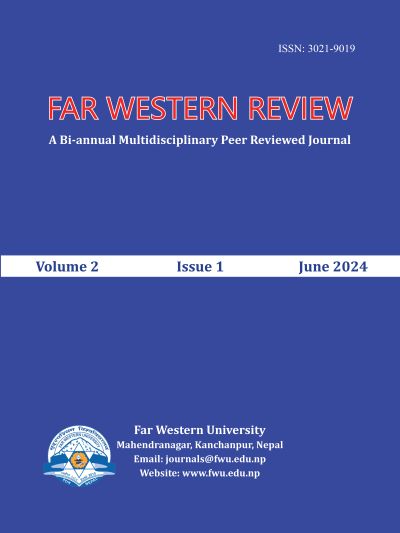Macroeconomic Impact of Value Added Tax in Nepal: A 2SLS and 3SLS Approach
DOI:
https://doi.org/10.3126/fwr.v2i1.70534Keywords:
Value added tax, total consumption, economic growth, government expendi ture, simultaneous equationAbstract
The study’s aim to evaluate the impact of VAT on macroeconomic variables (TCON, GDP, Import (M) and GOVEXP) and the reverse effects of Macro variables on VAT. This study included macroeconomic development variables such as GDP, GDP (-1), VAT, remittance (REM), total consumption (TCON), export (X), import (M), gross fixed capital formation (GFCF), bank rate (BRATE), trade openness (TOPEN), government expenditure (GOVEXP) and one period lagged government expenditure (GOVEXP (-1)). However, this study has been enhanced over previous analyses by incorporating 45 years of nominal data from 1974/1975 to 2018/19. It examines the connection between VAT and significant macroeconomic variables such as GDP, GDP (-1), REM TCON, X, M, GFCF, BRATE, TOPEN, GOVEXP and GOVEXP (-1). To address the challenges of simultaneous equation bias and inconsistent findings, this study utilized the two-stage least squares (2SLS) and three-stage least squares (3SLS) methodologies to assess the impact of VAT on macroeconomic variables. The findings of the study are that value-added tax (VAT) negatively impacts TCON. VAT positively and significantly impacts on GDP, import(M), and GOVEXP. The study revealed that while TOPEN negatively affected Nepal’s GDP, GOVEXP, GFCF, and X had a significant and positive influence on GDP.
Downloads
Downloads
Published
How to Cite
Issue
Section
License

This work is licensed under a Creative Commons Attribution-NonCommercial 4.0 International License.
CC BY-NC: This license allows reusers to distribute, remix, adapt, and build upon the material in any medium or format for noncommercial purposes only, and only so long as attribution is given to the creator.




